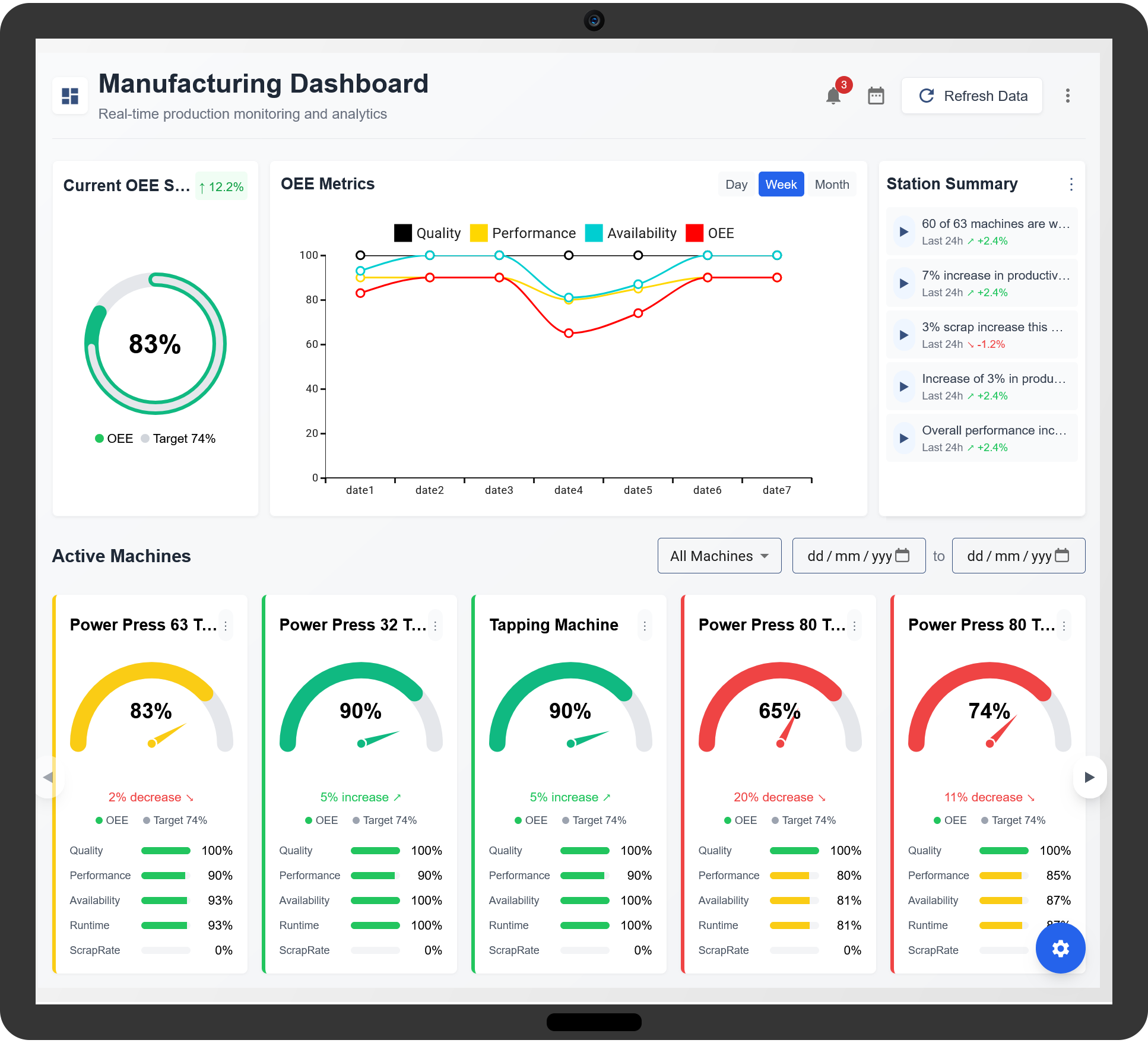Overall Equipment Effectiveness (OEE) is a critical metric for measuring manufacturing efficiency. One of the most effective ways to improve OEE is by identifying and reducing the Six Big Losses in manufacturing. These losses impact machine availability, performance, and quality, leading to reduced productivity and increased operational costs.

Understanding the Six Big Losses
The Six Big Losses are categorized into three main areas of OEE:
- Availability Losses: Downtime caused by breakdowns and setup adjustments.
- Performance Losses: Inefficiencies due to minor stops and speed reductions.
- Quality Losses: Defects and rework that lead to wasted production.
1. Equipment Failures
Unexpected breakdowns cause unplanned downtime, reducing machine availability. Common causes include poor maintenance, worn-out components, and electrical faults.
How to Reduce Equipment Failures
- Implement preventive maintenance schedules.
- Utilize predictive maintenance with real-time monitoring.
- Train operators on proper machine handling.
2. Setup and Adjustments
Frequent changeovers, tool adjustments, and machine calibrations lead to production delays.
How to Minimize Setup Time
- Use SMED (Single-Minute Exchange of Die) techniques to speed up changeovers.
- Standardize setup procedures and provide clear documentation.
- Automate adjustments where possible.
3. Idling and Minor Stops
Short, frequent stops due to material jams, misfeeds, or sensor issues disrupt production flow.
How to Reduce Minor Stops
- Identify common root causes through data analysis.
- Improve material handling and machine calibration.
- Regularly inspect and maintain sensors and feeders.
4. Reduced Speed
Machines running below optimal speed lead to performance losses.
How to Optimize Production Speed
- Calibrate equipment to run at designed speed.
- Train operators to maintain optimal operating conditions.
- Identify and eliminate speed-related inefficiencies.
5. Process Defects
Scrap and rework due to defects reduce overall quality output.
How to Improve Product Quality
- Enhance quality control processes.
- Use automated inspection systems.
- Improve raw material quality and process stability.
6. Reduced Yield
Startup losses due to defective parts during machine warm-up or new production runs affect quality.
How to Reduce Yield Losses
- Optimize machine startup procedures.
- Perform thorough initial quality checks.
- Use advanced process monitoring tools.
Six Big Losses in Manufacturing: How to Improve OEE
What are the Six Big Losses in manufacturing?
The Six Big Losses in manufacturing are equipment failures, setup and adjustment time, idling and minor stoppages, reduced speed, defects and rework, and yield losses.
How do equipment failures affect OEE?
Equipment failures lead to unplanned downtime, reducing availability and directly impacting Overall Equipment Effectiveness (OEE).
What is setup and adjustment loss in manufacturing?
Setup and adjustment losses occur when machines are being prepared for a new production run, causing downtime and reducing productivity.
How does idling and minor stoppages impact OEE?
Frequent minor stoppages disrupt workflow and lower OEE by reducing machine availability and efficiency.
What causes reduced speed losses in production?
Machines running below optimal speed due to inefficiencies, wear and tear, or operator-related factors contribute to reduced speed losses.
How do defects and rework affect OEE?
Defective products lead to rework or scrap, lowering OEE by reducing quality and increasing production costs.
What is yield loss, and how does it impact efficiency?
Yield loss occurs when materials or products are wasted during production, negatively affecting OEE by reducing overall output.
How can manufacturers reduce equipment failure losses?
Implementing preventive and predictive maintenance programs helps reduce breakdowns and improves equipment reliability.
What strategies help minimize setup and adjustment losses?
Using SMED (Single-Minute Exchange of Die) techniques and standardizing setup procedures reduces setup time and improves efficiency.
How can idling and minor stoppages be prevented?
Monitoring production lines, using automation, and training operators can help identify and eliminate causes of minor stoppages.
What techniques improve machine speed efficiency?
Regular maintenance, operator training, and optimizing machine settings help improve speed efficiency and reduce losses.
How can manufacturers reduce defects and rework?
Implementing quality control measures, automation, and real-time monitoring helps detect and prevent defects early.
What role does predictive maintenance play in reducing losses?
Predictive maintenance uses data and analytics to detect potential failures before they occur, reducing unplanned downtime.
How does real-time monitoring improve OEE?
Real-time monitoring provides instant insights into production performance, allowing quick corrective actions to minimize losses.
What steps can manufacturers take to improve OEE overall?
Manufacturers can improve OEE by reducing downtime, optimizing processes, implementing automation, and continuously monitoring performance.